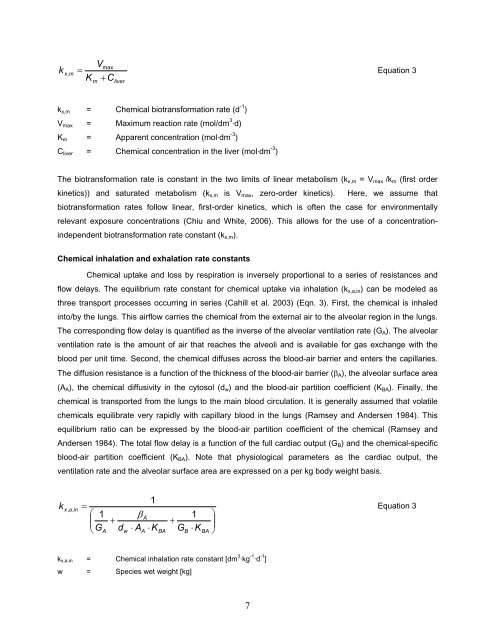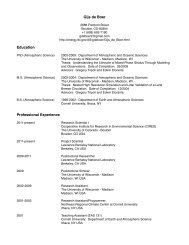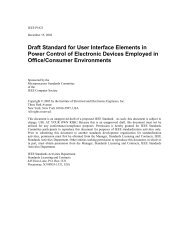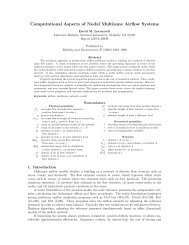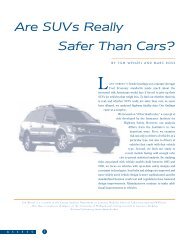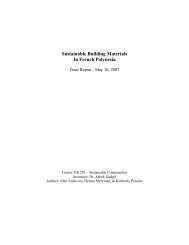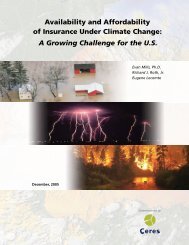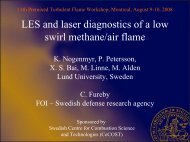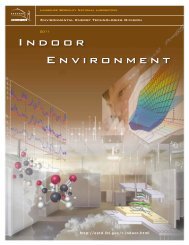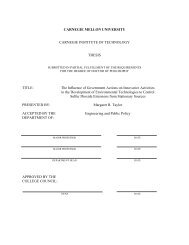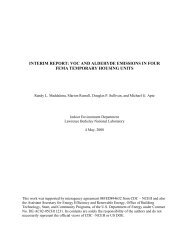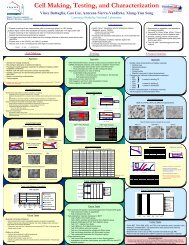Combining Biological Allometry, Chemical Equilibrium And ... - OSTI
Combining Biological Allometry, Chemical Equilibrium And ... - OSTI
Combining Biological Allometry, Chemical Equilibrium And ... - OSTI
You also want an ePaper? Increase the reach of your titles
YUMPU automatically turns print PDFs into web optimized ePapers that Google loves.
Vmax<br />
k x,<br />
m =<br />
Equation 3<br />
K + C<br />
m<br />
liver<br />
kx,m = <strong>Chemical</strong> biotransformation rate (d -1 )<br />
Vmax = Maximum reaction rate (mol/dm 3 ·d)<br />
Km = Apparent concentration (mol·dm -3 )<br />
Cliver = <strong>Chemical</strong> concentration in the liver (mol·dm -3 )<br />
The biotransformation rate is constant in the two limits of linear metabolism (kx,m = Vmax /km (first order<br />
kinetics)) and saturated metabolism (kx,m is Vmax, zero-order kinetics). Here, we assume that<br />
biotransformation rates follow linear, first-order kinetics, which is often the case for environmentally<br />
relevant exposure concentrations (Chiu and White, 2006). This allows for the use of a concentrationindependent<br />
biotransformation rate constant (kx,m).<br />
<strong>Chemical</strong> inhalation and exhalation rate constants<br />
<strong>Chemical</strong> uptake and loss by respiration is inversely proportional to a series of resistances and<br />
flow delays. The equilibrium rate constant for chemical uptake via inhalation (kx,a,in) can be modeled as<br />
three transport processes occurring in series (Cahill et al. 2003) (Eqn. 3). First, the chemical is inhaled<br />
into/by the lungs. This airflow carries the chemical from the external air to the alveolar region in the lungs.<br />
The corresponding flow delay is quantified as the inverse of the alveolar ventilation rate (GA). The alveolar<br />
ventilation rate is the amount of air that reaches the alveoli and is available for gas exchange with the<br />
blood per unit time. Second, the chemical diffuses across the blood-air barrier and enters the capillaries.<br />
The diffusion resistance is a function of the thickness of the blood-air barrier (βA), the alveolar surface area<br />
(AA), the chemical diffusivity in the cytosol (dw) and the blood-air partition coefficient (KBA). Finally, the<br />
chemical is transported from the lungs to the main blood circulation. It is generally assumed that volatile<br />
chemicals equilibrate very rapidly with capillary blood in the lungs (Ramsey and <strong>And</strong>ersen 1984). This<br />
equilibrium ratio can be expressed by the blood-air partition coefficient of the chemical (Ramsey and<br />
<strong>And</strong>ersen 1984). The total flow delay is a function of the full cardiac output (GB) and the chemical-specific<br />
blood-air partition coefficient (KBA). Note that physiological parameters as the cardiac output, the<br />
ventilation rate and the alveolar surface area are expressed on a per kg body weight basis.<br />
k<br />
x,<br />
a,<br />
in<br />
=<br />
⎛ 1<br />
⎜<br />
⎝ G<br />
A<br />
+<br />
d<br />
w<br />
β A<br />
⋅ A ⋅ K<br />
A<br />
1<br />
BA<br />
+<br />
G<br />
B<br />
1<br />
⋅ K<br />
kx,a,in = <strong>Chemical</strong> inhalation rate constant [dm 3 ·kg -1 ·d -1 ]<br />
w = Species wet weight [kg]<br />
BA<br />
⎞<br />
⎟<br />
⎠<br />
7<br />
Equation 3


